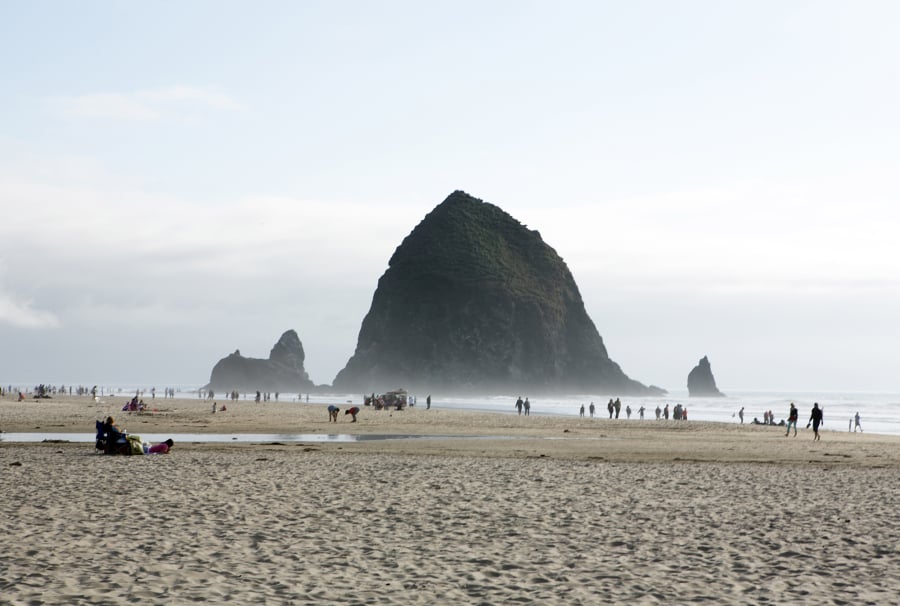CANNON BEACH, Ore. — A boy picked up a chunk of stone and started methodically smashing barnacles in the protected marine garden at Haystack Rock.
As he hit the small creatures and pummeled the rocks they lived on last Friday before he was told to leave the garden, he was unwittingly mimicking the natural forces that are slowly reshaping and could eventually erase the massive landmark behind him.
Geologists predict Haystack Rock will erode away in the next 2,000 to 3,000 years, but volunteers and staff with the Haystack Rock Awareness Program say the rock is already changing in front of their eyes.
Falling rocks — including one chunk approximately the size of a pickup truck — have prompted extra precautions for visitor safety.
“What they were seeing in the last 12 months is much more than we’ve ever been alerted to before,” said Dawn Harris, visitor services manager for the U.S. Fish and Wildlife Service’s Oregon Coast National Wildlife Refuge Complex, which includes Haystack Rock.
New signs about rockfall hazards will go up when awareness program staff are on site. The Fish and Wildlife Service will keep a closer eye on the ancient sea stack during aerial surveys of protected rocks, reefs and islands.
Last year, huge chunks sheared away from Haystack Rock’s southern and northern sides, mostly landing on ledges beyond or above where visitors congregate. Dark patches and trenches where the rocks fell away are visible on the sea stack’s face.
“We hear rocks falling every day,” said Alan Quimby, an environmental interpreter for the awareness program.
Nesting birds often disturb small rocks up top, he said, but recent rockfalls include some of the biggest he has witnessed in years. He didn’t see the pickup truck-sized rock hurtle to the ground, but he heard it: a roar and crash like a bomb blast.
It isn’t clear why Quimby and others saw so much erosion last year. Still, the rock has always taken a beating — both from the ocean and from people.
Dynamite
In 1968, a Fish and Wildlife crew blasted a lower ledge off Haystack Rock with dynamite, hoping to discourage rock climbers. Then there are the constant, natural forces of weather, wind and waves. The more extreme weather that comes with climate change is expected to exacerbate erosion on the coast.
And there isn’t much anyone can do.
Haystack Rock was designated a national wildlife refuge in 1976 and as a marine garden in 1990.
The Oregon Parks and Recreation Department and the state Department of Fish and Wildlife have a hand in managing parts of the rock, the marine garden and beach around it, and the creatures that live there. The U.S. Fish and Wildlife Service manages the part of the rock that is considered a national wildlife refuge and habitat for migratory and local birds, basically from the barnacle line up.
The federal agency does not actively monitor Haystack Rock — or any other of the state’s roughly 1,850 protected rocks, reefs and islands — for erosion. But the recent changes at Haystack Rock are concerning and the agency plans to pay more attention in years to come.
“Definitely we are very concerned and want to keep the finger on the pulse on potential impacts for nesting seabird habitat,” said Kelly Moroney, project leader for the Oregon Coast National Wildlife Refuge Complex.
Haystack Rock and other rocky islands in Oregon — with the exception of the iconic Tillamook Rock Lighthouse — are considered wilderness areas. Under the federal Wilderness Act, one of the directions Moroney must follow is to promote natural processes like erosion.
“We would actually be precluded from implementing stabilization efforts,” Moroney said. “Now, if there were an opportunity to do native plant restoration to help with protecting those habitats, that is an option.”
“It adds complexity to the management of those islands for sure,” he said.
What the agency and state and local partners can focus on for now is education, both to keep the public safe and to continue to preserve the natural resource.
Erosion at Haystack Rock will be a new message for the awareness program to communicate to visitors, said Lisa Habecker, the education and volunteer coordinator.
Typically, the organization talks about things such as the history of the rock, the many animals that live there and the steps taken to preserve habitat for everything from mussels to puffins.
Erosion may prove to be a tricky message.
Last year, Haystack Rock Awareness Program staff and volunteers interacted with nearly 1 million visitors. They may talk to hundreds of people in a single hour at the height of summer.
But despite all the attention visitors pay the rock, many still ignore the signs that tell them to keep out of restricted areas.



